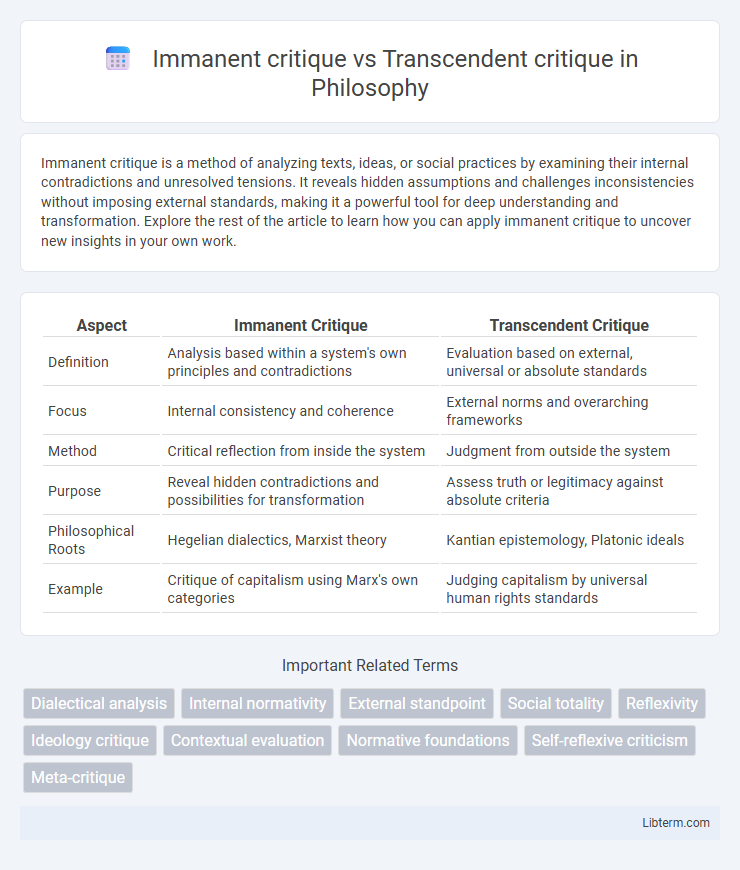Immanent critique is a method of analyzing texts, ideas, or social practices by examining their internal contradictions and unresolved tensions. It reveals hidden assumptions and challenges inconsistencies without imposing external standards, making it a powerful tool for deep understanding and transformation. Explore the rest of the article to learn how you can apply immanent critique to uncover new insights in your own work.
Table of Comparison
| Aspect | Immanent Critique | Transcendent Critique |
|---|---|---|
| Definition | Analysis based within a system's own principles and contradictions | Evaluation based on external, universal or absolute standards |
| Focus | Internal consistency and coherence | External norms and overarching frameworks |
| Method | Critical reflection from inside the system | Judgment from outside the system |
| Purpose | Reveal hidden contradictions and possibilities for transformation | Assess truth or legitimacy against absolute criteria |
| Philosophical Roots | Hegelian dialectics, Marxist theory | Kantian epistemology, Platonic ideals |
| Example | Critique of capitalism using Marx's own categories | Judging capitalism by universal human rights standards |
Defining Immanent Critique
Immanent critique involves analyzing a theory or system from within its own principles and assumptions, revealing internal contradictions or inconsistencies without appealing to external standards. This method enables a deeper understanding of the subject by exposing flaws inherent in its framework, fostering transformative insights rooted in the system itself. In contrast, transcendent critique assesses the subject based on external criteria or higher principles, often leading to judgment from outside the system's internal logic.
Understanding Transcendent Critique
Transcendent critique examines ideas or systems by applying external standards or principles beyond the system itself, aiming to reveal contradictions or limitations from an outside perspective. This method contrasts with immanent critique, which analyzes concepts based on their internal logic and coherence. Understanding transcendent critique is essential for evaluating philosophical theories, social structures, and ethical frameworks through universal or external criteria.
Philosophical Origins of Immanent Critique
Immanent critique originates from German idealism, particularly the work of Hegel, who emphasized examining concepts within their own historical and logical development rather than from external standards. This method contrasts with transcendent critique, which evaluates ideas based on external, often universal principles detached from their internal context. Immanent critique uncovers contradictions and tensions inherent in a system by engaging with its own presuppositions and frameworks.
Historical Development of Transcendent Critique
Transcendent critique historically emerged from Enlightenment philosophy, emphasizing universal principles beyond immediate experience, particularly in the works of Immanuel Kant and his successors. This form of critique aims to evaluate social and cultural phenomena against absolute, external standards or ideals, often grounded in metaphysical or epistemological frameworks. Its historical development contrasts with immanent critique, which arose from Hegelian dialectics and Marxist theory, focusing on internal contradictions and self-referential norms within social structures.
Key Differences Between Immanent and Transcendent Critique
Immanent critique evaluates ideas or systems from within their own framework, using internal logic and principles to identify contradictions or limitations, whereas transcendent critique assesses them from an external vantage point, applying outside standards or values. Immanent critique fosters deeper understanding by revealing inconsistencies embedded in the subject matter itself, while transcendent critique challenges the subject by contrasting it with broader or alternative paradigms. The key difference lies in the point of reference: immanent critique operates inside the system's own boundaries, and transcendent critique operates outside those boundaries.
Advantages of Immanent Critique
Immanent critique offers the advantage of analyzing social and cultural systems from within, allowing for a nuanced understanding of internal contradictions and tensions that drive change. This method fosters constructive reform by engaging directly with the subject's own principles and values, promoting transformation grounded in existing frameworks. Its focus on internal dynamics enhances the relevance and applicability of critiques, facilitating practical and context-sensitive improvements.
Strengths of Transcendent Critique
Transcendent critique excels by providing an external, overarching standard that transcends specific contexts, enabling the identification of fundamental inconsistencies or limitations within a system. Its strength lies in offering a comprehensive perspective that challenges existing norms through universal principles or ideals, fostering transformative change beyond immediate conditions. By distancing itself from internal assumptions, transcendent critique can reveal blind spots overlooked by immanent critique, thus promoting deeper structural or conceptual reforms.
Major Thinkers and Theories
Immanent critique, rooted in Hegelian dialectics, is utilized by major thinkers like Theodor Adorno and Jurgen Habermas to analyze social phenomena from within their internal contradictions, emphasizing self-reflective transformation. Transcendent critique, associated with Kantian philosophy, involves evaluating ideas or systems against external, universal standards, with Immanuel Kant and Karl Popper as key figures advocating normative frameworks beyond empirical conditions. These approaches shape critical theory and epistemology by contrasting internal systemic analysis with external evaluative benchmarks.
Applications in Social and Political Analysis
Immanent critique involves analyzing social and political structures from within, using existing values and norms to expose contradictions and possibilities for reform, often applied in critical theory and Marxist analysis. Transcendent critique takes an external or overarching standpoint, evaluating systems against universal principles or ideals to highlight fundamental flaws or propose radical change. Both methods inform social justice movements and policy-making, where immanent critique supports transformative practices and transcendent critique underpins normative frameworks for justice.
Contemporary Debates and Future Directions
Immanent critique in contemporary debates emphasizes internal contradictions within social systems, fostering transformative potential from within, while transcendent critique appeals to external, often idealized standards to evaluate societal norms. Recent scholarship explores hybrid approaches that integrate both methods to address complex ethical and political issues, enhancing critical reflexivity and normative guidance. Future directions prioritize interdisciplinary frameworks and digital technologies to refine critique strategies, aiming to navigate globalization and socio-political fragmentation effectively.
Immanent critique Infographic

 libterm.com
libterm.com